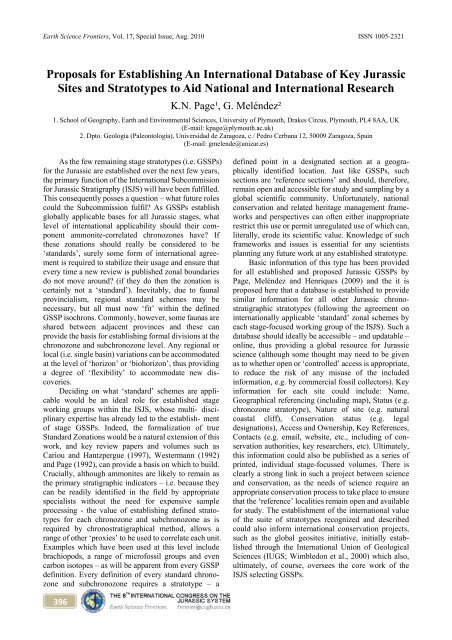in Jurassic and Cretaceous Stratigraphy
in Jurassic and Cretaceous Stratigraphy
in Jurassic and Cretaceous Stratigraphy
You also want an ePaper? Increase the reach of your titles
YUMPU automatically turns print PDFs into web optimized ePapers that Google loves.
Earth Science Frontiers, Vol. 17, Special Issue, Aug. 2010 ISSN 1005-2321<br />
Proposals for Establish<strong>in</strong>g An International Database of Key <strong>Jurassic</strong><br />
Sites <strong>and</strong> Stratotypes to Aid National <strong>and</strong> International Research<br />
396<br />
K.N. Page¹, G. Meléndez²<br />
1. School of Geography, Earth <strong>and</strong> Environmental Sciences, University of Plymouth, Drakes Circus, Plymouth, PL4 8AA, UK<br />
(E-mail: kpage@plymouth.ac.uk)<br />
2. Dpto. Geología (Paleontología), Universidad de Zaragoza, c./ Pedro Cerbuna 12, 50009 Zaragoza, Spa<strong>in</strong><br />
(E-mail: gmelende@unizar.es)<br />
As the few rema<strong>in</strong><strong>in</strong>g stage stratotypes (i.e. GSSPs)<br />
for the <strong>Jurassic</strong> are established over the next few years,<br />
the primary function of the International Subcommision<br />
for <strong>Jurassic</strong> <strong>Stratigraphy</strong> (ISJS) will have been fulfilled.<br />
This consequently posses a question – what future roles<br />
could the Subcommission fulfil? As GSSPs establish<br />
globally applicable bases for all <strong>Jurassic</strong> stages, what<br />
level of <strong>in</strong>ternational applicability should their com-<br />
ponent ammonite-correlated chronozones have? If<br />
these zonations should really be considered to be<br />
‘st<strong>and</strong>ards’, surely some form of <strong>in</strong>ternational agree-<br />
ment is required to stabilize their usage <strong>and</strong> ensure that<br />
every time a new review is published zonal boundaries<br />
do not move around? (if they do then the zonation is<br />
certa<strong>in</strong>ly not a ‘st<strong>and</strong>ard’). Inevitably, due to faunal<br />
prov<strong>in</strong>cialism, regional st<strong>and</strong>ard schemes may be<br />
necessary, but all must now ‘fit’ with<strong>in</strong> the def<strong>in</strong>ed<br />
GSSP isochrons. Commonly, however, some faunas are<br />
shared between adjacent prov<strong>in</strong>ces <strong>and</strong> these can<br />
provide the basis for establish<strong>in</strong>g formal divisions at the<br />
chronozone <strong>and</strong> subchronozone level. Any regional or<br />
local (i.e. s<strong>in</strong>gle bas<strong>in</strong>) variations can be accommodated<br />
at the level of ‘horizon’ or ‘biohorizon’, thus provid<strong>in</strong>g<br />
a degree of ‘flexibility’ to accommodate new dis-<br />
coveries.<br />
Decid<strong>in</strong>g on what ‘st<strong>and</strong>ard’ schemes are appli-<br />
cable would be an ideal role for established stage<br />
work<strong>in</strong>g groups with<strong>in</strong> the ISJS, whose multi- disci-<br />
pl<strong>in</strong>ary expertise has already led to the establish- ment<br />
of stage GSSPs. Indeed, the formalization of true<br />
St<strong>and</strong>ard Zonations would be a natural extension of this<br />
work, <strong>and</strong> key review papers <strong>and</strong> volumes such as<br />
Cariou <strong>and</strong> Hantzpergue (1997), Westermann (1992)<br />
<strong>and</strong> Page (1992), can provide a basis on which to build.<br />
Crucially, although ammonites are likely to rema<strong>in</strong> as<br />
the primary stratigraphic <strong>in</strong>dicators – i.e. because they<br />
can be readily identified <strong>in</strong> the field by appropriate<br />
specialists without the need for expensive sample<br />
process<strong>in</strong>g - the value of establish<strong>in</strong>g def<strong>in</strong>ed strato-<br />
types for each chronozone <strong>and</strong> subchronozone as is<br />
required by chronostratigraphical method, allows a<br />
range of other ‘proxies’ to be used to correlate each unit.<br />
Examples which have been used at this level <strong>in</strong>clude<br />
brachiopods, a range of microfossil groups <strong>and</strong> even<br />
carbon isotopes – as will be apparent from every GSSP<br />
def<strong>in</strong>ition. Every def<strong>in</strong>ition of every st<strong>and</strong>ard chrono-<br />
zone <strong>and</strong> subchronozone requires a stratotype – a<br />
def<strong>in</strong>ed po<strong>in</strong>t <strong>in</strong> a designated section at a geogra-<br />
phically identified location. Just like GSSPs, such<br />
sections are ‘reference sections’ <strong>and</strong> should, therefore,<br />
rema<strong>in</strong> open <strong>and</strong> accessible for study <strong>and</strong> sampl<strong>in</strong>g by a<br />
global scientific community. Unfortunately, national<br />
conservation <strong>and</strong> related heritage management frame-<br />
works <strong>and</strong> perspectives can often either <strong>in</strong>appropriate<br />
restrict this use or permit unregulated use of which can,<br />
literally, erode its scientific value. Knowledge of such<br />
frameworks <strong>and</strong> issues is essential for any scientists<br />
plann<strong>in</strong>g any future work at any established stratotype.<br />
Basic <strong>in</strong>formation of this type has been provided<br />
for all established <strong>and</strong> proposed <strong>Jurassic</strong> GSSPs by<br />
Page, Meléndez <strong>and</strong> Henriques (2009) <strong>and</strong> the it is<br />
proposed here that a database is established to provide<br />
similar <strong>in</strong>formation for all other <strong>Jurassic</strong> chrono-<br />
stratigraphic stratotypes (follow<strong>in</strong>g the agreement on<br />
<strong>in</strong>ternationally applicable ‘st<strong>and</strong>ard’ zonal schemes by<br />
each stage-focused work<strong>in</strong>g group of the ISJS). Such a<br />
database should ideally be accessible – <strong>and</strong> updatable –<br />
onl<strong>in</strong>e, thus provid<strong>in</strong>g a global resource for <strong>Jurassic</strong><br />
science (although some thought may need to be given<br />
as to whether open or ‘controlled’ access is appropriate,<br />
to reduce the risk of any misuse of the <strong>in</strong>cluded<br />
<strong>in</strong>formation, e.g. by commercial fossil collectors). Key<br />
<strong>in</strong>formation for each site could <strong>in</strong>clude: Name,<br />
Geographical referenc<strong>in</strong>g (<strong>in</strong>clud<strong>in</strong>g map), Status (e.g.<br />
chronozone stratotype), Nature of site (e.g. natural<br />
coastal cliff), Conservation status (e.g. legal<br />
designations), Access <strong>and</strong> Ownership, Key References,<br />
Contacts (e.g. email, website, etc., <strong>in</strong>clud<strong>in</strong>g of con-<br />
servation authorities, key researchers, etc). Ultimately,<br />
this <strong>in</strong>formation could also be published as a series of<br />
pr<strong>in</strong>ted, <strong>in</strong>dividual stage-focussed volumes. There is<br />
clearly a strong l<strong>in</strong>k <strong>in</strong> such a project between science<br />
<strong>and</strong> conservation, as the needs of science require an<br />
appropriate conservation process to take place to ensure<br />
that the ‘reference’ localities rema<strong>in</strong> open <strong>and</strong> available<br />
for study. The establishment of the <strong>in</strong>ternational value<br />
of the suite of stratotypes recognized <strong>and</strong> described<br />
could also <strong>in</strong>form <strong>in</strong>ternational conservation projects,<br />
such as the global geosites <strong>in</strong>itiative, <strong>in</strong>itially estab-<br />
lished through the International Union of Geological<br />
Sciences (IUGS; Wimbledon et al., 2000) which also,<br />
ultimately, of course, oversees the core work of the<br />
ISJS select<strong>in</strong>g GSSPs.

















